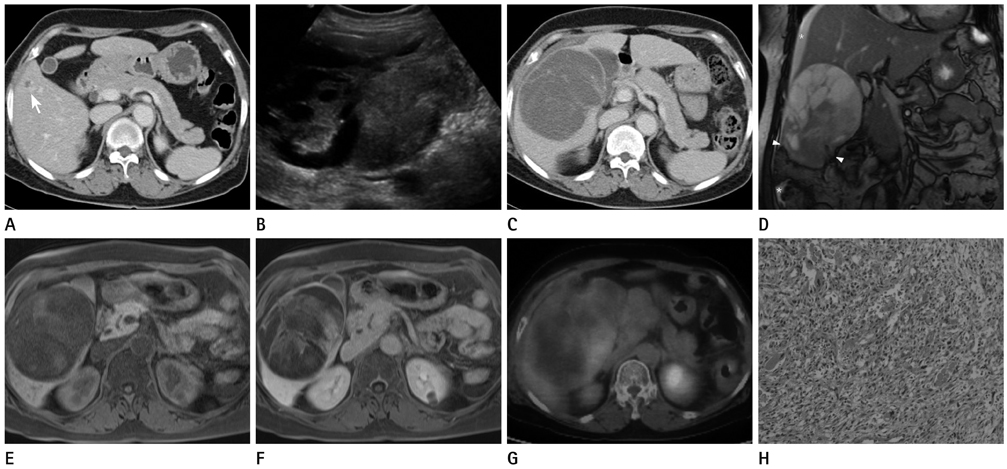J Korean Soc Radiol.
2013 Dec;69(6):457-460.
Undifferentiated Embryonal Sarcoma of the Liver in an Adult: The Verification of the High Growth Rate in the Tumor
- Affiliations
-
- 1Department of Radiology, Daegu Fatima Hospital, Daegu, Korea. praia-zorlborn@hanmail.net
Abstract
- We report the radiologic findings of a rare case of undifferentiated embryonal sarcoma of liver (UES) in a 64-year-old female. To our knowledge, this is the unique case of adult UES that provide verification of the high growth rate of the tumor.
Figure
Reference
-
1. Stocker JT, Ishak KG. Undifferentiated (embryonal) sarcoma of the liver: report of 31 cases. Cancer. 1978; 42:336–348.2. Li XW, Gong SJ, Song WH, Zhu JJ, Pan CH, Wu MC, et al. Undifferentiated liver embryonal sarcoma in adults: a report of four cases and literature review. World J Gastroenterol. 2010; 16:4725–4732.3. Buetow PC, Buck JL, Pantongrag-Brown L, Marshall WH, Ros PR, Levine MS, et al. Undifferentiated (embryonal) sarcoma of the liver: pathologic basis of imaging findings in 28 cases. Radiology. 1997; 203:779–783.4. Ros PR, Olmsted WW, Dachman AH, Goodman ZD, Ishak KG, Hartman DS. Undifferentiated (embryonal) sarcoma of the liver: radiologic-pathologic correlation. Radiology. 1986; 161:141–145.5. Joshi SW, Merchant NH, Jambhekar NA. Primary multilocular cystic undifferentiated (embryonal) sarcoma of the liver in childhood resembling hydatid cyst of the liver. Br J Radiol. 1997; 70:314–316.6. Martí-Bonmatí L, Ferrer D, Menor F, Galant J. Hepatic mesenchymal sarcoma: MRI findings. Abdom Imaging. 1993; 18:176–179.7. Psatha EA, Semelka RC, Fordham L, Firat Z, Woosley JT. Undifferentiated (embryonal) sarcoma of the liver (USL): MRI findings including dynamic gadolinium enhancement. Magn Reson Imaging. 2004; 22:897–900.8. Vermess M, Collier NA, Mutum SS, Crofton ME. Misleading appearance of a rare malignant liver tumour on computed tomography. Br J Radiol. 1984; 57:262–265.9. Baron PW, Majlessipour F, Bedros AA, Zuppan CW, Ben-Youssef R, Yanni G, et al. Undifferentiated embryonal sarcoma of the liver successfully treated with chemotherapy and liver resection. J Gastrointest Surg. 2007; 11:73–75.
- Full Text Links
- Actions
-
Cited
- CITED
-
- Close
- Share
- Similar articles
-
- Embryonal Sarcoma of the Liver in an Adult
- Erratum: Undifferentiated Embryonal Sarcoma of the Liver in an Adult: The Verification of the High Growth Rate in the Tumor
- Undifferentiated embryonal sarcoma of the liver in an adult patient
- Undifferentiated Sarcoma of the Liver in Adult: A Case Report and Review of the Literature
- Undifferentiated Embryonal Sarcoma of Liver in Child


